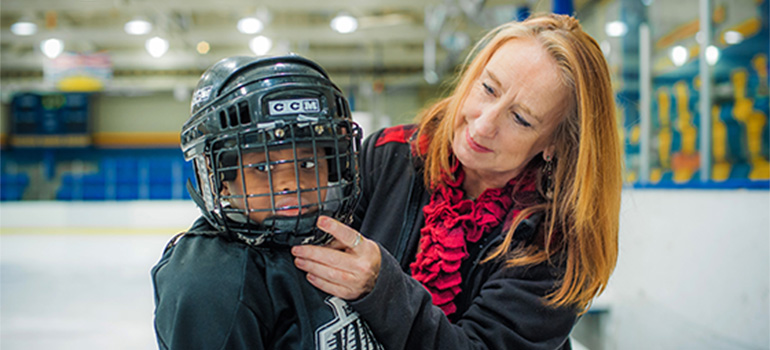
UBC Prof. Jane Roskams says hockey parents, coaches and clubs should be aware that concussions can have different impacts at different ages Photo: Martin Dee
Jane Roskams on what can be done to prevent head injuries in youth hockey
Hockey is responsible for a large number of reported youth head injuries each year, in part of because of the huge number of participants and the risk inherent in the sport. With hockey season in full swing, Prof. Jane Roskams, UBC’s Brain Research Centre and Life Sciences Institute, discusses what parents and youth hockey organizations can do to help keep young athletes safe.
What can parents or youth hockey leagues do to minimize head injuries?
Youth hockey leagues are working hard on this, including local leagues now participating in longitudinal imaging studies with UBC to begin to tackle this head-on.
In hockey, the athlete should be learning how to fall, how to brace for impact, and officials should enforce every policy they can to minimize risk. Being in the best shape – and the most flexible – can make a big difference in how a body can handle an impact.
Parents and coaches can talk to their kids, especially if they have identified players who are too physical, and leagues can exert bans on kids who break the rules. Coaches can teach injury prevention techniques at the earliest stage of game development, and good sportsmanship.
How should parents and coaches approach body checking in youth hockey?
Youth hockey leagues can try harder to provide options for allowing playing opportunities without body checking. Some leagues do and it can make the game a lot more enjoyable for determined athletes who want to push themselves but aren’t aiming for the NHL. Less emphasis on body checking and fighting can add up to safer brains. Asking if these other options are available would be a good thing to do.
How can technology help in increasing safety in hockey?
There is inherent risk in every sport. Helmets can protect some physical damage to the skull, but a hard hit when your brain starts bouncing off the inside of your skull creates bruising inside the brain whether you have a helmet on or not.
I think as long as parents, coaches and clubs become aware that concussions can have different impacts at different ages, and keep on top of this as new data comes out, we can make a difference.
The CDC has excellent resource information that they update as soon as new findings are validated.